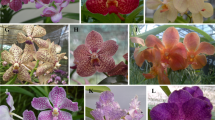Summary
Nuclear and cytoplasmic factors affect tissue culture response in wheat (Triticum aestivum), and cytoplasmic male sterility may enhance callus initiation in anther culture. Three wheat nuclear genotypes, each in normal and two alien cytoplasms conferring cytoplasmic male sterility, were evaluated for callus initiation frequency in anther culture. Nuclear genotype had the greatest effect on callus initiation, but cytoplasm and nucleus X cytoplasm interaction also produced significant effects. The nuclear genotype of ‘Chris’ outperformed ‘Butte’ and ‘Coteau’ in all cytoplasms. Ordinary wheat and Triticum timopheevi cytoplasms outperformed Aegilops speltoides cytoplasm. Cytoplasmic male sterility did not increase callus initiation. This suggests manipulating the nuclear genotype is the best strategy for improving the capacity of wheat to initiate callus in anther culture.
Similar content being viewed by others
References
Breiman A., 1987. Mitochondrial DNA diversity in the genera of Triticum and Aegilops revealed by Southern blot hybridization. Theor. Appl. Genet. 73: 563–570.
Charmet G. & S.Bernard, 1984. Diallel analysis of androgenetic plant production in hexaploid Triticale (X. tritosecale, Wittmack). Theor. Appl. Genet. 69: 55–61.
Ding-gang H. & O.Jen-wun, 1984. Callus and plantlet formation from cultured wheat anthers at different developmental stages. Plant Sci. Lett. 33: 71–79.
Heberle-Bors E., 1982. In vitro embryogenesis in Nicotiana tabacum L. and its relation to pollen sterility, sex balance, and floral induction of the pollen donor plants. Planta 156: 396–401.
Heberle-Bors E. & W.Odenbach, 1985. In vitro pollen embryogenesis and cytoplasmic male sterility in Triticum aestivum. Z. Pflanzenzuchtg. 95: 14–22.
Heberle-Bors E & J.Reinert, 1980. Isolated pollen cultures and pollen dimorphism. Naturwissenschaften 67: 311.
Joppa L.R., F.H.McNeal & J.R.Welsh, 1966. Pollen and anther development in cytoplasmic male sterile wheat. Crop Sci. 6: 296–297.
Kinoshita T. & T.Mikami, 1984. Alloplasmic effects on callus proliferation and streptomycin resistance in common wheat. Seiken Ziho 32: 31–38.
Lazar M.D., G.W.Schaeffer & P.S.Baenziger, 1984. Cultivar and cultivar X environment effects on the development of callus and polyhaploid plants from anther cultures of wheat. Theor. Appl. Genet., 67: 273–277.
Ling T., H.Huang, C.Liang & P.Chun, 1978. The study of anther culture in ‘three lines’ breeding and utilization of heterosis in Oryza sativa subsp. Hsein. In: Proc. Symp. of Plant Tisue Culture, Science Press, Peking. pp. 213–222.
Lucken, K.A., 1973. Comparative use of cytoplasmic male sterility-fertility restoration systems in hybrid-wheat breeding. In: Proc. 4th Intl. Wheat Genetics Symp. pp. 361–366.
Maan S.S. & K.A.Lucken, 1971. Nucleo-cytoplasmic interactions involving Aegilops cytoplasms and Triticum genomes. J. Hered. 62: 149–152.
Maan S.S., 1979. Specificity of nucleo-cytoplasmic interactions in Triticum and Aegilops species (a review). Wheat Inf. Serv. 50: 71–79.
Mathias R.J., K.Fukui & C.N.Law, 1986. Cytoplasmic effects on the tissue culture response of wheat (Triticum aestivum) callus. Theor. Appl. Genet. 72: 70–75.
Mukai, Y., S.S. Maan, I. Panayotov & K. Tsunewaki, 1978. Comparative studies of the nucleus-cytoplasm hybrids of wheat produced by three research groups. In: Proc. 5th Int. Wheat Genet. Symp. Vol. 1 pp. 282–292.
Ogihara Y. & K.Tsunewaki, 1982. Molecular basis of the genetic diversity of the cytoplasm in Triticum and Aegilops. I. Diversity of the chloroplast genome and its lineage revealed by the restriction pattern of ct-DNAs. Jpn. J. Genet. 57: 371–396.
Picard E. & J.deBuyser, 1973. Obtention de plantules haploides de Triticum aestivum L. à partir de culture d'anthères in vitro. C.R. Acad. Sc. Paris 277-D: 1463–1466.
Qian C.M., A.Xu & G.H.Liang, 1986. Effects of low temperatures and genotypes on pollen development in wheat. Crop Sci. 26: 43–46.
Schaeffer G.W., P.S.Baenziger & J.Worley, 1979. Haploid plant development from anthers and in vitro embryo culture of wheat. Crop Sci. 19: 697–702.
Tsunewaki K. & Y.Ogihara, 1983. The molecular basis of genetic diversity among cytoplasms of Triticum and Aegilops species. II. On the origin of polyploid wheat cytoplasms as suggested by chloroplast DNA restriction fragment patterns. Genetics 104: 155–171.
Vasil I.K., 1980. Androgenetic haploids. In: I.K.Vasil (Ed), Perspectives in Plant Cell and Tissue Culture. Intl. Rev. Cytol. Suppl. 11A. Academic Press, NY.
Vedel F., F.Quetier, F.Dosba & G.Doussinault, 1978. Study of wheat phylogeny by EcoRI analysis of chloroplastic and mitochondrial DNAs. Plant Sci. Lett. 13: 97–102.
Author information
Authors and Affiliations
Rights and permissions
About this article
Cite this article
Becraft, P.W., Taylor, G.A. Effects of nucleus, cytoplasm and male sterile nucleus-cytoplasm combinations on callus initiation in anther culture of wheat. Euphytica 44, 235–240 (1989). https://doi.org/10.1007/BF00037530
Received:
Accepted:
Issue Date:
DOI: https://doi.org/10.1007/BF00037530




